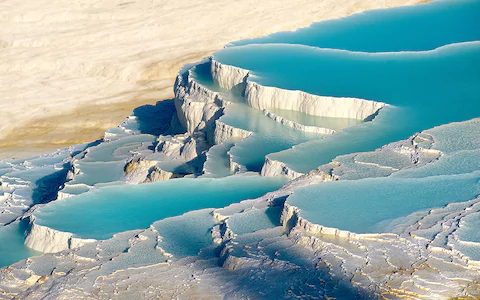The Mystifying Pools of Pamukkale
- 4Steps Voyage

- Aug 5, 2021
- 4 min read
Updated: Dec 22, 2021
Go to
Introduction
Cotton castle. Velvet white rocks. White paradise. Magically healing hot water springs. A UNESCO World Heritage Site in southwest Turkey, a visit to Pamukkale (Cotton Palace) also takes in the ancient ruins of Hierapolis, the once great city that was built around it. Water cascades from natural springs and down the white travertine terraces and forms stunning thermal pools perfect for a quick dip. It sounds more like a fairy tale than a real place. Add on top of that a beautifully photo-shopped picture to the brochure and you definitely have a good amount of visitors coming your way!

Pamukkale, which means “cotton castle” in Turkish, is a natural site in Denizli in southwestern Turkey. The area is famous for a carbonate mineral left by the flowing water.Over the course of thousands of years, this mineral has formed white water pools famous around the whole world for their healing properties. Pamukkale is so much more than hot pools and in this guide, we’ll tell you about all the cool activities you can do there!
The Legend of Pamukkale
As every mysterious place in the world, Pamukkale has a strong legend that makes the place even more appealing. People believe that back in the days, there was a Turkish young girl that no one wanted to marry because she was ugly. Depressed, the girl tried to commit suicide throwing herself off the travertine. She fell into a natural pool and survived the fall. The water in the pool turned her into a beautiful girl who caught the attention of the Turkish lord Denizli while he was passing by the place. He fell in love with the girl and decided to marry her. That is why people nowadays believe that in addition to the health benefits, the rocks in Pamukkale can make you more beautiful.

Understanding the Mystery of Pamukkale

In order to explain the mystery of Pamukkale, we must understand the geology of this place. The terraces of the spot are made out of travertine, a sedimentary rock that is deposited by water.
There are 17 hot springs in Pamukkale with temperatures ranging from 35 degrees to 100 degrees. The water, once emerging from the spring, is then transported 320m to the head of the terraces where it deposits calcium carbonate. Once the water reaches the surface, carbon dioxide is de-gassed and the result is deposition of calcium carbonate. The deposition continues until the carbon dioxide in the water and in the air is balanced. Calcium carbonate is deposited as a soft jelly, but in the travertine the carbonate hardens.
Reasons to Visit Pamukkale
Health Benefits: Pamukkale is considered a natural health spa thanks to its many benefits. According to many, the water provides a cure against asthma and rheumatism.
Additionally, the water brings benefits to the skin, eyes, helps recover from high blood pressure, kidney stones, stroke, physical exhaustion, circulatory issues, digestive maladies, chronic disorders and nutritional disorders.
Best time to visit Pamukkale is the spring, as the weather and the climate is at a normal level. In the summer, the temperature can go up to 40+ degrees and humidity is another issue.
A Stunning Tourist Destination:

Up until the 1980s, Pamukkale was a local destination in Turkey, and not many people outside of the country knew the benefits of the water. But then the local authorities decided to market and develop Pamukkale as a spa center. Motels were razed and the land became clear, the road up the slope was converted into pools, and visitors were allowed in them to walk, play, splash and even soak.
But most importantly, the pools are designed for swimmers who like to experience the health and beauty benefits of the hot water.
In 1988, Pamukkale was made a World Heritage Site. To protect the site, access to terraces is limited and visitors must follow the main pathway. Small pools are the only ones allowed for swimming and bathing in order to protect the thermal waters.
Best Time to Visit Pamukkale

The best season to visit Pamukkale is Spring. The weather there is usually quite comfortable between April and June and a lot of flowers will be blooming around the site. Fall, from September to October is also a good time to visit Pamukkale but that time of the year can be a bit rainy. Visiting Pamukkale in winter is not recommended because you’ll be very cold when you come out of the springs, not to mention the occasional snowfalls.
How to Get to Pamukkale
Since Pamukkale is one of the major touristic sites in Turkey, it’s easily accessed from other cities and towns around the country. Most big cities in Turkey have buses that go to Denizli, the closest town to Pamukkale.
References
Introduction: https://www.roughguides.com/gallery/20-seriously-weird-places-around-the-world/, https://www.journalofnomads.com/things-to-do-in-pamukkale/#What_is_the_best_time_to_visit_Pamukkale
The Legend of Pamukkale, Understanding the Mystery of Pamukkale, Health Benefits, A Stunning Tourist Destination: https://www.documentarytube.com/articles/pamukkale-in-turkey-is-one-of-the-most-mysterious-and-healthiest-places-in-the-world
Best Time to Visit Pamukkale, How to Get to Pamukkale: https://www.journalofnomads.com/things-to-do-in-pamukkale/#What_is_the_best_time_to_visit_Pamukkale
Pictures:










Getting tempted to visit !